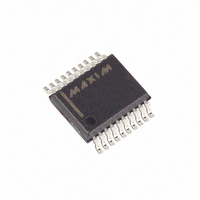MAX1203BCAP+ Maxim Integrated Products, MAX1203BCAP+ Datasheet - Page 16

MAX1203BCAP+
Manufacturer Part Number
MAX1203BCAP+
Description
IC ADC 12BIT 8CH 20-SSOP
Manufacturer
Maxim Integrated Products
Datasheet
1.MAX1202BCPP.pdf
(24 pages)
Specifications of MAX1203BCAP+
Number Of Bits
12
Sampling Rate (per Second)
133k
Data Interface
MICROWIRE™, Serial, SPI™
Number Of Converters
1
Power Dissipation (max)
7.5mW
Voltage Supply Source
Dual ±
Operating Temperature
0°C ~ 70°C
Mounting Type
Surface Mount
Package / Case
20-SSOP
Resolution
12 bit
Interface Type
Serial (4-Wire, SPI, Microwire)
Snr
70 dB
Voltage Reference
4.096 V
Supply Voltage (max)
5.25 V
Supply Voltage (min)
4.75 V
Maximum Power Dissipation
640 mW
Maximum Operating Temperature
+ 70 C
Mounting Style
SMD/SMT
Input Voltage
5 V
Minimum Operating Temperature
0 C
Lead Free Status / RoHS Status
Lead free / RoHS Compliant
Figure 11a shows the serial-interface timing necessary
to perform a conversion every 15 SCLK cycles in exter-
nal clock mode. If CS is low and SCLK is continuous,
guarantee a start bit by first clocking in 16 zeros.
Most microcontrollers (µCs) require that data transfers
occur in multiples of eight clock cycles; 16 clocks per
conversion is typically the fastest that a µC can drive
the MAX1202/MAX1203. Figure 11b shows the
serial-interface timing necessary to perform a conver-
sion every 16 SCLK cycles in external clock mode.
When power is first applied and if SHDN is not pulled
low, internal power-on reset circuitry activates the
MAX1202/MAX1203 in internal clock mode, ready to
convert with SSTRB = high. After the power supplies
are stabilized, the internal reset time is 100µs. No con-
versions should be performed during this phase.
SSTRB is high on power-up, and if CS is low, the first
logical 1 on DIN is interpreted as a start bit. Until a con-
version takes place, DOUT shifts out zeros.
In addition to its shutdown function, SHDN also selects
internal or external compensation. The compensation
affects both power-up time and maximum conversion
speed. Compensated or not, the minimum clock rate is
100kHz due to droop on the sample-and-hold.
Float SHDN to select external compensation. The
Typical Operating Circuit uses a 4.7µF capacitor at REF.
A value of 4.7µF or greater ensures stability and allows
converter operation at the 2MHz full clock speed.
External compensation increases power-up time (see
the section Choosing Power-Down Mode, and Table 5).
Internal compensation requires no external capacitor at
REF, and is selected by pulling SHDN high. Internal
compensation allows for the shortest power-up times,
but the external clock must be limited to 400kHz during
the conversion.
You can save power by placing the converter in a low-
current shutdown state between conversions. Select full
power-down or fast power-down mode via bits 1 and 0
of the DIN control byte with SHDN high or floating
(Tables 2 and 6). Pull SHDN low at any time to shut
down the converter completely. SHDN overrides bits 1
and 0 of the control byte.
Full power-down mode turns off all chip functions that draw
quiescent current, reducing I
__________ Applications Information
5V, 8-Channel, Serial, 12-Bit ADCs
with 3V Digital Interface
16
______________________________________________________________________________________
Reference-Buffer Compensation
Choosing Power-Down Mode
DD
and I
Power-On Reset
SS
typically to 2µA.
Power-Down
For the MAX1202, fast power-down mode turns off all
circuitry except the bandgap reference. With fast
power-down mode, the supply current is 30µA. Power-up
time can be shortened to 5µs in internal compensation
mode.
Since the MAX1203 does not have an internal reference,
power-up times coming out of full or fast power-down are
identical.
I
(DIN, SCLK, CS) is held high in either power-down
mode. The actual shutdown current depends on the
state of the digital inputs, the voltage applied to the digi-
tal inputs (V
ing temperature. Figure 12c shows the maximum I
increase for each digital input held high in power-down
mode for different operating conditions. This current is
cumulative, so if all three digital inputs are held high, the
additional shutdown current is three times the value
shown in Figure 12c.
In both software power-down modes, the serial interface
remains operational, but the ADC does not convert.
Table 5 shows how the choice of reference-buffer com-
pensation and power-down mode affects both power-up
delay and maximum sample rate. In external compensa-
tion mode, power-up time is 20ms with a 4.7µF compen-
sation capacitor (200ms with a 33µF capacitor) when the
capacitor is initially fully discharged. From fast
power-down, start-up time can be eliminated by using
low-leakage capacitors that do not discharge more than
1/2LSB while shut down. In power-down, the capacitor
has to supply the current into the reference (typically
1.5µA) and the transient currents at power-up.
Figures 12a and 12b show the various power-down
sequences in both external and internal clock modes.
Software power-down is activated using bits PD1 and
PD0 of the control byte. As shown in Table 6, PD1 and
PD0 also specify the clock mode. When software
power-down is asserted, the ADC continues to operate
in the last specified clock mode until the conversion is
complete. The ADC then powers down into a low quies-
cent-current state. In internal clock mode, the interface
remains active and conversion results can be clocked
out even though the MAX1202/MAX1203 have already
entered software power-down.
The first logical 1 on DIN is interpreted as a start bit and
powers up the MAX1202/MAX1203. Following the start
bit, the control byte also determines clock and
power-down modes. For example, if the DIN word con-
tains PD1 = 1, the chip remains powered up. If PD1 = 0,
power-down resumes after one conversion.
DD
shutdown current can increase if any digital input
IH
), the supply voltage (V
Software Power-Down
DD
), and the operat-
DD











